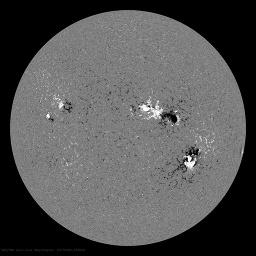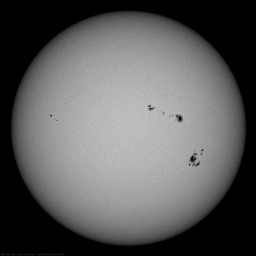I noticed on many examples sun spots are near the equator of the Sun. Why are there no sun spots closer to the poles of the Sun?
3 Answers
Indeed the regions where sunspots form tend to be equatorial, with sunspots concentrated near the regions at +/- 40° latitude.
Sunspots are regions at temperature lower than that of the surrounding as for they are closing point of the sun magnetic field. At sunspots, the magnetic field is much higher than average and that hinders heat transport to the photosphere due to a reduced convection.
While the magnetic field of the sun is loosely speaking and as seen by far described as a dipole field (similar to that of Earth or of a magnetic bar), its local distribution is complicated.
Picture from https://www.windows2universe.org/sun/sun_magnetic_field.html showing the magnetic field and spots forming at the loops closing areas.
Besides the fact that the magnetic field flips every roughly 11 years, and keeps changing in meantime, sun, which is not rock solid, has a latitude depending rotational speed. This, superimposed to the dynamo mechanism for stars magnetic field generation, is responsible for "carrying the local magnetic field along with rotation" and forces the field closing before the geometrical poles.
In the words of Wikipedia under the entry stellar magnetic field https://en.m.wikipedia.org/wiki/Stellar_magnetic_field
"spots are regions of intense magnetic activity on the surface of a star. (On the Sun they are termed sunspots.) These form a visible component of magnetic flux tubes that are formed within a star's convection zone. Due to the differential rotation of the star, the tube becomes curled up and stretched, inhibiting convection and producing zones of lower than normal temperature".
This doesn't provide a clear picture of why the magnetic field behaves as such, but at least does tell that sunspots are a consequence of the magnetic field behaviour.
Understanding the magnetic field of stars and even that of Earth is indeed ongoing research. A little more articulated answer is given by the above linked Wikipedia page, particularly by sections Field generation and Surface activity.
I would add some details to the answer above. The interior of the sun is like a dipole or relatively consistent magnetic field that flips about once every 11 years, but it also does something interesting, it kind of goes from dipole to quadrupole before flipping.
See image and answer to another stack exchange sunspot question. Note, this image reflects the interior of the sun only.
That the Sun "flips" every 11 years suggests that it's much more dynamic that Earth's core which flips only after tens of thousands of years.
The entire sun is made up of plasma, so it's outer layers, not just it's inner layers can carry a charge and generate a magnetic field. The Sun's outer layer flows faster at the equator (every 25 days) than it's poles (every 34 days) and that leads to rapid twisting of magnetic field lines while the Sun's interior rotates more as a single unit. And we have a word for large twisting magnetic field lines on the Sun's surface. We call them sunspots and they are visible dark spot on the sun, not visible to the naked eye, but observable with the right equipment. Galileo is often credited with the first recorded observation of sunspots, but there are records of Chinese observation and recording of them going back to long before that, 1000 years before Christ.
Like the Sun, the Earth also undergoes a twisting of sorts, of it's magnetic field prior to a magnetic pole switch. This generates something, not quite like sunspots, but there is a temporary complexity to Earth's magnetic field as well.
See image here for Earth. (having trouble embedding).
Sunspots range from the Solar equator up to about 40 degrees North or South as noted in teh other answer. During weak sunspot cycles, they mostly stay below 30 degrees, during strong ones, they mostly stay below 40 degrees however there are rare incidents of sunspots considerably above 40 degrees North or South, more common during strong sunspot periods, but still rare. See image below.
The reason for this - finally getting to your question,
Is basically that the twisting due to variations in rotation rate is more likely to happen in the 0-40 degree latitude range. That said, actually understanding all the mechanisms of the Sun's magnetic field is a significant undertaking and not well understood. This is perhaps an oversimplified answer.
Lucky for us, most sunspot driven coronal mass ejections or CMEs shoot above or below the solar equator which is near the ecliptic (tilted about 6 degrees off, so, OK, not all that near but near enough), but on average the majority of sunspots form with greater latitude than that, so many miss the Earth orbital region, shooting above or below the plane of the ecliptic or giving glancing blows. A direct hit from a very large CME could cause havoc with our electrical grid and perhaps satellites as well. Many of the larger sunspots during peak sunspot activity form further up in the 15-25 degree latitude range on the Sun.
-
1$\begingroup$ I like this because just citing quadrupole suggest a complicated pattern with lines closing at the center in a lobed fashion. They must enter photosphere at about 40° (see middle sun in the first figure).Though my view can be a naive it is suggestive. $\endgroup$ Commented Feb 18, 2019 at 11:38
-
$\begingroup$ @Alchimista I voted your answer up and I think you came to the specific question more directly than I did. Both answers are good I think. $\endgroup$– userLTKCommented Feb 18, 2019 at 11:44
-
$\begingroup$ "Just" did not refer to my vote, but to citing quadrupole. Has to be taken as a positive comment. :) Indeed it does show why the field enters at middle latitudes. Of course both answers don't tell exactly why it is etc $\endgroup$ Commented Feb 18, 2019 at 11:50
Here are some additional comments to the previous answers.
What is observed:
- At the beginning of a solar cycle (that lasts on average 11 years), sunspots appear around 30 degrees of latitude and progressively they appear lower and lower in latitude. At the end of the cycle they appear close to the equator. This is summarized in the butterfly diagram that shows the latitude in function of time:
How to explain it:
- Sunspots are regions of strong magnetic fields. The following images (from SDO satellite) represent the magnetic fields at the surface of the sun (left side) and a white light image taken at the same moment (right side). It is obvious that each sunspot correspond to a strong magnetic field (black/white patch).
- In order to produce sunspots, the magnetic field lines have to rise up and to come out of the sun, this configuration is called 'toroidal magnetic field'. On the other hand the simple configuration with only a north and a south pole is called a 'poloidal magnetic field'. Both configuration are illustrated below:
- It is thought that the sunspot cycle is produced by an oscillation between the poloidal field and the toroidal one. The toroidal field is then created around 30 degrees of latitude and a mechanism of conveyor belt is responsible to make the latitude of appearance progressively lower and lower. The cycle ends (after ~11 years) when sunspots reach the equator (that corresponds to a low toroidal field and strong poloidal field). Afterwards a new toroidal field is created and the sunspots of the new cycle appear at 30 degrees of latitude. This is illustrated on the figure below.
Note that we are currently close to a solar minimum (few sunspots and high poloidal field). The first sunspots of the next cycle should appear at 'high' latitude (~30 degrees).







